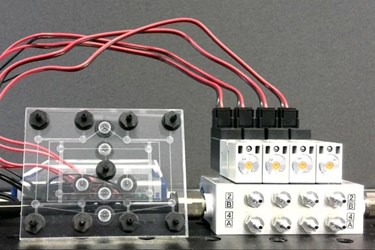Air-powered computer memory to control soft robots

Engineers at UC Riverside have developed an air-powered computer memory that can be used to control soft robots.
The work, published in the open-access journal, PLOS One, looks to overcomes one of the biggest obstacles to advancing soft robotics which is the mismatch between pneumatics and electronics.
Pneumatic soft robots use pressurized air to move soft, rubbery limbs and grippers and not only offer a superior performance to traditional rigid robots when it comes to performing delicate tasks but for humans are much safer to be around – espcially when it comes to working alongside cobots.
At present pneumatic soft robots still use electronic valves and computers to maintain the position of the robot’s moving parts which can add considerable cost, size, and power demands to soft robots, limiting their feasibility.
In response, a team led by bioengineering doctoral student Shane Hoang, his advisor, bioengineering professor William Grover, computer science professor Philip Brisk, and mechanical engineering professor Konstantinos Karydis, have developed a pneumatic logic “memory” for a soft robot, eliminating the electronic memory currently used for that purpose.
In pneumatic logic, air, not electricity, flows through circuits or channels and air pressure is used to represent on/off or true/false. In modern computers, these logical states are represented by 1 and 0 in code to trigger or end electrical charges.
The researchers made their pneumatic random-access memory, or RAM, chip using microfluidic valves instead of electronic transistors. Originally designed to control the flow of liquids on microfluidic chips, these valves can also control the flow of air.
The valves remain sealed against a pressure differential even when disconnected from an air supply line, creating trapped pressure differentials that function as memories and maintain the states of a robot’s actuators. Dense arrays of these valves can perform advanced operations and reduce the expensive, bulky, and power-consuming electronic hardware typically used to control pneumatic robots.
After modifying the microfluidic valves to handle larger air flow rates, the team produced an 8-bit pneumatic RAM chip able to control larger and faster-moving soft robots, and incorporated it into a pair of 3D-printed rubber hands. The pneumatic RAM uses atmospheric-pressure air to represent a “0” or FALSE value, and vacuum to represent a “1” or TRUE value. The soft robotic fingers are extended when connected to atmospheric pressure and contracted when connected to vacuum.
In theory, this system could be used to operate other robots without any electronic hardware and only a battery-powered pump to create a vacuum. The researchers noted that without positive pressure anywhere in the system -only normal atmospheric air pressure – there is no risk of accidental overpressurization and violent failure of the robot or its control system.
Robots using this technology would be especially safe for delicate use on or around humans, such as wearable devices for infants with motor impairments.